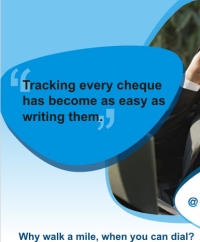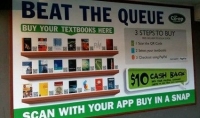According to the World Retail Banking Report 2012 co-authored by Cap Gemini and EFMA and a few other research reports published recently, customers are viewing the Internet as one of the two most important channels of retail banking worldwide, the branch being the other.
OTOH, many banks, nonbanking financial service providers and others are virtually treating the web as a non-existent channel while communicating the value proposition of their telephone and mobile banking channels and mobile payment services.
#GoFigure.
Let me cite a few examples of the “web amnesia” exhibited by the finserv industry.
 Bank: I recently received an email from my bank – a Top 5 private sector bank in India – with an offer to use its Phone Banking channel and receive a free gift. To promote this channel, the bank used the tagline “Why walk a mile when you can dial?” to check the status of a cheque. This is a great pitch for phone banking, just that it’s outdated by more than a decade. This very bank launched Internet Banking some 12-13 years ago. Since then, many customers, including me, have been checking the status of cheques – and doing lots more – with a few mouse clicks on its NetBanking portal instead of “walking a mile”. (For the moment, let me ignore the fact that cheque usage has itself been steadily dropping ever since banks launched ACH- and RTGS-equivalent EFT systems on their Internet Banking portals around 6-7 years ago).
Bank: I recently received an email from my bank – a Top 5 private sector bank in India – with an offer to use its Phone Banking channel and receive a free gift. To promote this channel, the bank used the tagline “Why walk a mile when you can dial?” to check the status of a cheque. This is a great pitch for phone banking, just that it’s outdated by more than a decade. This very bank launched Internet Banking some 12-13 years ago. Since then, many customers, including me, have been checking the status of cheques – and doing lots more – with a few mouse clicks on its NetBanking portal instead of “walking a mile”. (For the moment, let me ignore the fact that cheque usage has itself been steadily dropping ever since banks launched ACH- and RTGS-equivalent EFT systems on their Internet Banking portals around 6-7 years ago).
 Online Payment Provider: According to this Finextra article, a bookstore in Australia “lets students beat the queues with QR codes”. The queue-busting solution has been provided by a leading online payment provider that has recently forayed into physical stores. To use it, students visiting the store would need a smartphone, have a QR code reader app installed on it and know how to scan QR codes. I’ve no doubt that at least 75% of the student population in Australia would be digitally native enough to fulfill these three prerequisites. But, by the same token, won’t they simply order the books online instead of visiting the store, especially during the peak season when they know the place is going to be crowded (Yes, I did check, the company does have a website that accepts orders online). Or, is it that, despite being tech savvy, they’d prefer to visit the store for the instant gratification of walking out with the ordered books in hand? Even assuming that there are several students in that category, they’re unlikely to find much appeal in the queue-busting alternative since it doesn’t make the books available for instant store pickup. The way it works, books ordered via this option are shipped a day or two later to students’ homes.
Online Payment Provider: According to this Finextra article, a bookstore in Australia “lets students beat the queues with QR codes”. The queue-busting solution has been provided by a leading online payment provider that has recently forayed into physical stores. To use it, students visiting the store would need a smartphone, have a QR code reader app installed on it and know how to scan QR codes. I’ve no doubt that at least 75% of the student population in Australia would be digitally native enough to fulfill these three prerequisites. But, by the same token, won’t they simply order the books online instead of visiting the store, especially during the peak season when they know the place is going to be crowded (Yes, I did check, the company does have a website that accepts orders online). Or, is it that, despite being tech savvy, they’d prefer to visit the store for the instant gratification of walking out with the ordered books in hand? Even assuming that there are several students in that category, they’re unlikely to find much appeal in the queue-busting alternative since it doesn’t make the books available for instant store pickup. The way it works, books ordered via this option are shipped a day or two later to students’ homes.
 Mobile Network Operator: This Top 3 Indian MNO has recently launched a Mobile Money service. The MNO is promoting mobile bill payment, a major use case of its service, by emphasizing that it provides an alternative to standing in queues for hours to pay bills at the biller’s physical stores, or “relationship centers” as it calls them. Fact is, most billers, including this MNO, have launched Internet-based bill payments years ago. Some of them, like my energy utility, have done a great job of eliminating the traditional areas of friction that have plagued similar systems in the past, thereby boosting adoption in recent times (See MSEB Tops Online Bill Payment Consumer Experience for details). In short, bill payment has been free of queues for a long time now for those who want to avoid them.
Mobile Network Operator: This Top 3 Indian MNO has recently launched a Mobile Money service. The MNO is promoting mobile bill payment, a major use case of its service, by emphasizing that it provides an alternative to standing in queues for hours to pay bills at the biller’s physical stores, or “relationship centers” as it calls them. Fact is, most billers, including this MNO, have launched Internet-based bill payments years ago. Some of them, like my energy utility, have done a great job of eliminating the traditional areas of friction that have plagued similar systems in the past, thereby boosting adoption in recent times (See MSEB Tops Online Bill Payment Consumer Experience for details). In short, bill payment has been free of queues for a long time now for those who want to avoid them.
I could go on with many more examples but I hope you get my drift.
Given that they’ve invested millions in setting up their web channel, why’re banks and others alike ignoring it while promoting their mobile services? Let me hazard a few guesses to explain their behavior:
- People involved in the promotion campaigns for mobile services rarely use the online channel in their own personal lives for banking, shopping and bill payments, thereby losing top-of-the-mind recall for it
- They’re targeting a new segment of customers for their mobile services which is characterized by people at the bottom-of-the-pyramid who have mobile phones with data connectivity but lack PCs with Internet access. I’m convinced that this segment is sizable ever since I saw a janitor at an Indian airport tapping away on an iPhone / clone and heard that 70% of taxi and autorickshaw drivers in Indian metros have smartphones. But, I’m not so sure if this segment is ready for the advertised mobile services at this point.
- Good old silo mentality of each channel. This is not unique to banks as the above examples involving a bookseller and a telecom company prove
- Poor marketing.
“Web amnesia” alienates loyal web channel users. Regardless of how they got it, banks and FIs should get rid of it. They should reposition the mobile channel as a solution to the pain areas faced by these users with the web channel (instead of comparing it with physical channels). That way, they’d stand a great chance of recruiting their loyal web channel users as early adopters for their new mobile channel.